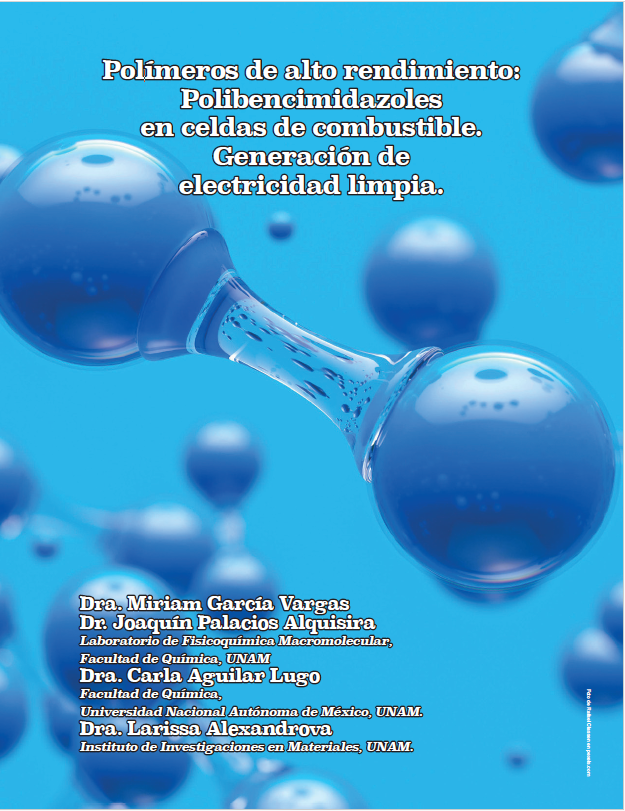Polímeros de alto rendimiento
Polibencimidazoles en celdas de combustible. Generación de electricidad limpia
Keywords:
polymers, polybenzimidazoles, cells, electricity
Abstract
Fuel cell technology is a promising path to obtaining electrical energy. Fuel cells generate electricity and heat during the electrochemical reaction that occurs between oxygen and hydrogen to form water. The type of electrolyte used in these cells determines their effectiveness in creating the conductivity necessary for ion transport. Proton exchange membrane fuel cells (PEMFC) are those that offer the best future prospects. The polybenzimidazole family constitutes a group of attractive materials to be applied as polymeric electrolytes in PEMFC. In the present work, a review focused on the synthesis, processing and applications of polybenzimidazoles as fuel cells is presented.
Downloads
Download data is not yet available.
References
Abdelkareem, M. A., Elsaid, K., Wilberforce, T., Kamil, M., Sayed, E. T., & Olabi, A. (2021). Environmental aspects of fuel cells: A review. Science of the Total Environment, 752, 141803. https://doi.org/ 10.1016/j.scitotenv.2020.141803.
Aili, D., Henkensmeier, D., Martin, S., Singh, B., Hu, Y., Jensen, J. O., Cleemann, L. N., & Li, Q. (2020). Polybenzimidazole- Based High-Temperature Polymer Electrolyte Membrane Fuel Cells: New Insights and Recent Progress. In Electrochemical Energy Reviews (Vol. 3, Issue 4). Springer Singapore. https://doi. org/10.1007/s41918-020-00080-5.
Escorihuela, J., Olvera-Mancilla, J., Alexandrova, L., del Castillo, L. F., & Compañ, V. (2020). Recent progress in the development of composite membranes based on polybenzimidazole for high temperature proton exchange membrane (PEM) fuel cell applications. Polymers, 12(9). https:// doi.org/10.3390/POLYM12091861.
Fan, L., Tu, Z., & Chan, S. H. (2021). Recent development of hydrogen and fuel cell technologies: A review. Energy Reports, 7, 8421–8446. https://doi.org/10.1016/j. egyr.2021.08.003.
Hardman, S., & Tal, G. (2018). Who are the early adopters of fuel cell vehicles? International Journal of Hydrogen Energy, 43(37), 17857–17866. https://doi.org/ 10.1016/j.ijhydene.2018.08.006.
Kalathil, A., Raghavan, A., & Kandasubramanian, B. (2019). Polymer Fuel Cell Based on Polybenzimidazole Membrane: A Review. Polymer-Plastics Technology and Materials, 58(5), 465–497. https://doi.org/ 10.1080/03602559.2018.1482919.
Kirubakaran, A., Jain, S., & Nema, R. K. (2009). A review on fuel cell technologies and power electronic interface. Renewable and Sustainable Energy Reviews, 13(9), 2430–2440. https://doi.org/10.1016/j. rser.2009.04.004.
Sannigrahi, A., Arunbabu, D., Murali Sankar, R., & Jana, T. (2007). Aggregation behavior of polybenzimidazole in aprotic polar. Macromolecules, 40(8), 2844–2851. https://doi.org/10.1021/ma070049q.
Seng, L. K., Masdar, M. S., & Shyuan, L. K. (2021). Ionic liquid in phosphoric acid-doped polybenzimidazole (Pa-pbi) as electrolyte membranes for pem fuel cells: A review. Membranes, 11(10). https://doi. org/10.3390/membranes11100728.
Stambouli, A. B. (2011). Fuel cells: The expectations for an environmental-friendly and sustainable source of energy. Renewable and Sustainable Energy Reviews, 15(9), 4507–4520. https://doi.org/10.1016/j. rser.2011.07.100.
Aili, D., Henkensmeier, D., Martin, S., Singh, B., Hu, Y., Jensen, J. O., Cleemann, L. N., & Li, Q. (2020). Polybenzimidazole- Based High-Temperature Polymer Electrolyte Membrane Fuel Cells: New Insights and Recent Progress. In Electrochemical Energy Reviews (Vol. 3, Issue 4). Springer Singapore. https://doi. org/10.1007/s41918-020-00080-5.
Escorihuela, J., Olvera-Mancilla, J., Alexandrova, L., del Castillo, L. F., & Compañ, V. (2020). Recent progress in the development of composite membranes based on polybenzimidazole for high temperature proton exchange membrane (PEM) fuel cell applications. Polymers, 12(9). https:// doi.org/10.3390/POLYM12091861.
Fan, L., Tu, Z., & Chan, S. H. (2021). Recent development of hydrogen and fuel cell technologies: A review. Energy Reports, 7, 8421–8446. https://doi.org/10.1016/j. egyr.2021.08.003.
Hardman, S., & Tal, G. (2018). Who are the early adopters of fuel cell vehicles? International Journal of Hydrogen Energy, 43(37), 17857–17866. https://doi.org/ 10.1016/j.ijhydene.2018.08.006.
Kalathil, A., Raghavan, A., & Kandasubramanian, B. (2019). Polymer Fuel Cell Based on Polybenzimidazole Membrane: A Review. Polymer-Plastics Technology and Materials, 58(5), 465–497. https://doi.org/ 10.1080/03602559.2018.1482919.
Kirubakaran, A., Jain, S., & Nema, R. K. (2009). A review on fuel cell technologies and power electronic interface. Renewable and Sustainable Energy Reviews, 13(9), 2430–2440. https://doi.org/10.1016/j. rser.2009.04.004.
Sannigrahi, A., Arunbabu, D., Murali Sankar, R., & Jana, T. (2007). Aggregation behavior of polybenzimidazole in aprotic polar. Macromolecules, 40(8), 2844–2851. https://doi.org/10.1021/ma070049q.
Seng, L. K., Masdar, M. S., & Shyuan, L. K. (2021). Ionic liquid in phosphoric acid-doped polybenzimidazole (Pa-pbi) as electrolyte membranes for pem fuel cells: A review. Membranes, 11(10). https://doi. org/10.3390/membranes11100728.
Stambouli, A. B. (2011). Fuel cells: The expectations for an environmental-friendly and sustainable source of energy. Renewable and Sustainable Energy Reviews, 15(9), 4507–4520. https://doi.org/10.1016/j. rser.2011.07.100.

Published
2024-07-25
How to Cite
García Vargas, D. M., Palacios Alquisira, D. J., Aguilar Lugo, D. C., & Alexandrova, D. L. (2024). Polímeros de alto rendimiento: Polibencimidazoles en celdas de combustible. Generación de electricidad limpia. Contactos, Revista De Educación En Ciencias E Ingeniería, (133), 79 - 86. Retrieved from https://contactos.izt.uam.mx/index.php/contactos/article/view/397
Section
Artículos





